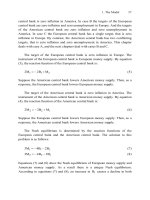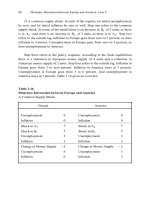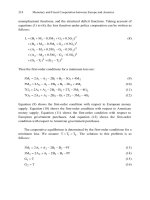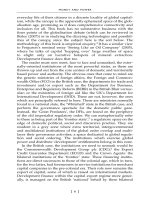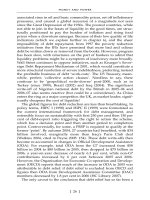Superior customer value in the new economy concepts and cases
Bạn đang xem bản rút gọn của tài liệu. Xem và tải ngay bản đầy đủ của tài liệu tại đây (2.45 MB, 406 trang )
SECOND EDITION
Superior Customer Value In The NEW
ECONOMY
Concepts and Cases
SECOND EDITION
Superior Customer Value In The
NEW ECONOMY
Concepts and Cases
William C.Johnson • Art Weinstein
CRC PRESS
Boca Raton London New York Washington, D.C.
This edition published in the Taylor & Francis e-Library, 2005.
“ To purchase your own copy of this or any of Taylor & Francis or Routledge’s collection of
thousands of eBooks please go to />Library of Congress Cataloging-in-Publication Data Johnson, William C. (William Charles),
1954– Superior customer value in the new economy: concepts and cases/William C.Johnson and
Art Weinstein.—2nd ed. p. cm. Rev. ed. of: Designing and delivering superior customer value/Art
Weinstein and William C.Johnson ISBN 1-57444-356-9 (alk paper) 1. Customer services—
Management. 2. Consumer satisfaction. I. Johnson, William C. II. Weinstein, Art. Designing and
delivering superior customer value, 1999. III. Title. HF5415.5.W442 2004 658.8′12–dc22
2004041820
This book contains information obtained from authentic and highly regarded sources. Reprinted
material is quoted with permission, and sources are indicated. A wide variety of references are
listed. Reasonable efforts have been made to publish reliable data and information, but the author
and the publisher cannot assume responsibility for the validity of all materials or for the
consequences of their use.
Neither this book nor any part may be reproduced or transmitted in any form or by any means,
electronic or mechanical, including photocopying, microfilming, and recording, or by any
information storage or retrieval system, without prior permission in writing from the publisher.
The consent of CRC Press LLC does not extend to copying for general distribution, for promotion,
for creating new works, or for resale. Specific permission must be obtained in writing from CRC
Press LLC for such copying.
Direct all inquiries to CRC Press LLC, 2000 N.W. Corporate Blvd., Boca Raton, Florida 33431.
Trademark Notice: Product or corporate names may be trademarks or registered trademarks, and
are used only for identification and explanation, without intent to infringe.
Visit the CRC Press Web site at www.crcpress.com
© 2004 by CRC Press LLC
No claim to original U.S. Government works
ISBN 0-203-50149-7 Master e-book ISBN
ISBN 0-203-61920-X (Adobe e-reader Format)
International Standard Book Number 1-57444-356-9 (Print Edition)
Library of Congress Card Number 2004041820
DEDICATION
To my mother, who understood value when she gave sacrificially through the years
WCJ
As always, to Sandee and Trevor, with love
AW
PREFACE
Designing and delivering superior customer value is the key to successful business
strategy in the 21st century. Value reigns supreme in today’s marketplace and
marketspace; customers will not pay more than a good or service is worth. Consider the
remarkable success of service and information providers such as Amazon.com; Dell
Computer; eBay; FedEx; General Electric; Hewlett-Packard; Intel; JetBlue Airways;
Lexus; Nordstrom; Wal-Mart; and Yahoo!—these companies truly know how to
maximize value for their customers.
According to the Marketing Science Institute, managing customers and understanding
customers are top-tier research priorities—ranked third and fifth, respectively—for the
years 2002 through 2004. The nine most important subtopics comprising the former area
are:
■ Customer retention
■ Measuring the lifetime value of a customer
■ Customer relationship management (CRM)
■ Managing loyalty to brand, channel, and employees
■ Customer expansion
■ Customer loyalty measurement
■ Customer acquisition
■ Managing customer experiences
■ Managing customer relationships
The four key subtopics in the latter area include:
■ Understanding/anticipating customers’ needs
■ Assessing the value to customers of firms’ actions
■ Customer experiences
■ Communicating customer knowledge within the firm1
These topics and much more are explored in the second edition of Superior Customer
Value in the New Economy.
Market-focused management posits that organizations should provide outstanding
value to customers because they are the most important organizational stakeholders. A
recent study of chief marketing and financial officers in Fortune 1000 firms affirmed this
proposition. Of 16 organizational goals mentioned, both groups of top executives rated
customer satisfaction as the primary business goal. The CMOs rated customer value
creation second, while the CFOs listed this third (long-term profit was cited second for
CFOs and third for CMOs).2
We have been researching, consulting, speaking, and writing about customer value in
service markets for more than 8 years. In addition, we have developed and teach the
definitive MBA course on the subject entitled “Delivering Superior Customer Value.”
We are truly convinced that developing the right value proposition (combining service,
quality, image, and price or S-Q-I-P™) must be the top priority for management.
A customer-driven business culture stresses service management; continuous quality
improvement; product and process innovation; and the use of Internet-based technologies
to provide focus and direction for the organization and ensure that outstanding customer
value will be offered. This, in turn, results in enhanced market performance.
Unfortunately, caught up in the daily pressures of running complex service and
information-based organizations, many managers lose sight of customers’ needs and
wants. As a result, the delivered experience often falls far short of customer expectations.
Great companies consistently meet and exceed customer desires. This book offers a
blueprint for benchmarking world-class service providers and how to respond more
effectively to customer demands. The second edition of Superior Customer Value was
produced from the latest thinking of the business and academic communities. It
summarizes and extends leading marketing and management work in the crucial area of
customer value (CV).
Building on a three-pronged approach to the study of CV—concepts, cases, and inchapter applications—the book serves as a comprehensive, integrative, and highly
practical marketing management resource. It explores important marketing planning and
strategy issues that emphasize relationship management strategies to keep customers
satisfied and delighted, as well as “best practices” on customer service, organizational
responsiveness, and market orientation. This perspective positively affects value-creating
organizations and management in fast-changing and highly competitive global service
industries.
Superior Customer Value was written to provide marketing practitioners, managers
and executives, and scholars (professors and graduate students) with an informative,
state-of-the-art guide to designing, implementing, and evaluating a CV strategy in service
and information-based organizations. The material appearing in the book has been
discussed at length in our MBA course “Delivering Superior Customer Value.” In
addition to the thousands of MBA students who have been exposed to these ideas,
hundreds of managers have benefited from our interpretation of the new customer value
paradigm via executive seminars and marketing doctoral courses.*
Each chapter in this book includes useful figures, tables, customer value checklists and
insights, end-of-chapter discussion questions, and additional reference material. Superior
Customer Value is organized into five parts:
*
For further discussion regarding the design of the MBA course “Delivering Superior Customer
Value,” see Weinstein, A. (1998) How to create an innovative MBA course, Mark. Educator,
Spring, 6.
Part I—Customer Value—the Building Blocks (Chapter 1 through Chapter 3) is
the foundation material. This section examines critical business issues such as
the importance of creating value for customers, customer orientation, and
value-creating processes and operations.
Part II—Creating Value through Services and e-Commerce is offered in
Chapter 4 through Chapter 6. In addition to our revised chapter on service
quality, this section features two new chapters on the service-dominant new
economy and online service quality.
Part III—Planning and Implementing a Winning Value Proposition (Chapter 7
through Chapter 9) explains how to build successful value propositions, pricing
techniques, and strategies for adding and promoting value.
Part IV—Delivering Long-Term Superior Value to Consumers (Chapter 10
through Chapter 11) wraps up the text/concepts portion of the book with
important material on customer retention and relationship marketing.
Part V—Customer Value Cases provides 18 detailed, “hands-on” examples of
how successful organizations create value for their customers. This section
opens with a framework for analyzing business cases via the customer value
funnel approach introduced in Chapter 1. More than half of the cases are
completely new for the second edition of the book. These include:
Boston Market
Delicato Family Wineries
Dow Corning
Edward Jones
FedEx
“Herding Cats” across the supply chain
JetBlue Airways
Lexmark International
Office Depot
Walgreens
Popular returning cases from the first edition of the book, most of which have
been revised, include:
The Grateful Dead
Harrah’s Entertainment
Nantucket Nectars
Newell-Rubbermaid
Pizza Hut
Publix Super Markets
StatePride Industrial Laundry
Time Insurance
Each case reveals an in-depth look at a dominant customer value theme (e.g., responding
to change, being customer oriented, customer loyalty, etc.) and offers end-of-case
questions to guide the analyses. The cases provide excellent learning opportunities to
model effective customer value behavior and practices.
We look forward to learning more about your customer value marketing experiences.
Feel free to contact us to discuss any of the material in our text.
Bill Johnson and Art Weinstein
Professors of Marketing, H.Wayne Huizenga School of Business and Entrepreneurship
Nova Southeastern University
3301 College Avenue
Ft. Lauderdale, FL 33314–7796
1–800–672–7223 (phone)
1–954–262–3965 (fax)
REFERENCES
1. 2002–2004 Research Priorities, (2002), Cambridge, MA: Marketing Science Institute,
/>2. Hall, P.L. and Williams, T.G. (1998) Marketing/finance executives’ personal and business value
perspectives: implications for market-focused management, Int. J. Value-Based Manage., 95,
125–157.
ACKNOWLEDGMENTS
Many individuals provided valuable input toward the preparation of Superior Customer
Value in the New Economy.
First and foremost, we thank our Nova Southeastern University associates. In
particular, Randy Pohlman, dean of the Huizenga School reenergized us to think about
customer value in marketing in a new light. Preston Jones, associate dean of academic
affairs, has provided us encouragement and the freedom to pursue meaningful teaching
and research activities.
Second, we thank our support team. Sylvia Lanski developed the concept for the book
cover. She and Barbara Ireland provided assistance with various figures and word
processed some of the case studies. Some of Isabell Layer’s computer graphics from the
1999 first edition were reproduced in this book.
Third, we acknowledge the following people for generously sharing their outstanding
case studies and other contributions. In alphabetical order, thank you to
Sally Baack
Eric W.Balinski
Barry Barnes
Hilton Barrett
Jim Barry
Jamie J.Bodouva
Nicholas W.Bodouva
Norapol (Paul) Chinuntdej
Jude Edwards
Robert Fast
John Feather
Trevor Fried
Armand Gilinsky, Jr.
Brett A.Gordon
Pam A.Gordon
Mariana Ilca
Jerry Johnson
Bahaudin (Dean) Mujtaba
Ram Reddy
Edward Schwerin
Alan Seidman
Murray Silverman
Fourth, we thank the thousands of MBA students who have benefited from taking the
“Delivering Superior Customer Value” course at NSU since 1996. In addition, hundreds
of doctoral students and executive seminar participants in marketing have provided us a
tremendous learning laboratory to sculpt and fine-tune our customer value-based
marketing philosophy.
Finally, we especially thank you for reading Superior Customer Value in the New
Economy.
THE AUTHORS
William C.Johnson is professor of marketing in the H.Wayne Huizenga School of
Business and Entrepreneurship at Nova Southeastern University, Ft. Lauderdale, Florida.
He earned his Ph.D. in 1985 from Arizona State University. Dr. Johnson is the coauthor
of Total Quality in Marketing; Business Process Orientation; and Supply Chain
Networks and Business Process Orientation: Advanced Strategies and Best Practices
(CRC/St. Lucie Press) and has published widely in marketing journals and trade
publications. He has consulted for companies in the health care, industrial chemical, soft
drink, and telecommunications industries, as well as small businesses. Dr. Johnson has
had experience in international education, giving seminars to businesspeople from Brazil,
Taiwan, China, Thailand, and Indonesia.
Art Weinstein is professor and chair of marketing in the H.Wayne Huizenga School of
Business and Entrepreneurship at Nova Southeastern University, Ft. Lauderdale, Florida.
He earned his Ph.D. in 1991 from Florida International University. Dr. Weinstein is the
author of Defining Your Market and The Handbook of Market Segmentation, 3rd Edition
(Haworth Press), as well as more than 50 scholarly articles and papers on customerfocused topics and marketing strategy issues. He was the founder and editor of the
Journal of Segmentation in Marketing. Dr. Weinstein has consulted for many high-tech
and service firms.
CONTENTS
PART I: CUSTOMER VALUE—THE BUILDING BLOCKS
1 Customers Want Top Value
2
2 Being Customer Oriented
14
3 Process and Customer Value
28
PART II: CREATING VALUE THROUGH SERVICES AND E-COMMERCE
4 The Service Sector and the New Economy
53
5 Defining and Managing Service Quality
66
6 Managing e-Service Quality
89
PART III: PLANNING AND IMPLEMENTING A WINNING VALUE
PROPOSITION
7 Defining and Refining the Value Proposition
102
8 Communicating Value through Price
121
9 Strategies for Adding and Promoting Value
142
PART IV: DELIVERING LONG-TERM SUPERIOR VALUE TO
CUSTOMERS
10 Maximizing Value through Retention Marketing
158
11 Creating Value through Customer and Supplier Relationships
174
PART V: CUSTOMER VALUE CASES: A PRIMER AND QUESTIONS FOR
ANALYSIS
Case 1: Boston Market—Process Flow Outcomes
202
Case 2: Delicato Family Winery—Building and Communicating Value
209
Case 3: Dow Corning—Customer Value and Segmentation
227
Case 4: Edward Jones—Managing Customer Relationships
238
Case 5: FedEx Corporation—A Customer Value Funnel Assessment
244
Case 6: The Grateful Dead—Creating Deadheads by Providing Drop-Dead
Customer Service
251
Case 7: Harrah’s Entertainment, Inc.—Loyalty Management
258
Case 8: “Herding Cats” across the Supply Chain
264
Case 9: JetBlue Airways—Adding Value
271
Case 10: Lexmark International—Creating New Market Space
283
Case 11: Nantucket Nectars—Perceived Quality
290
Case 12: Rubbermaid—Market Orientation
300
®
Case 13: Office Depot Goes Online—e-Service Quality
309
Case 14: Pizza Hut®—A Customer Loyalty Program
314
Case 15: Publix Super Markets, Inc.—Achieving Customer Intimacy
322
Case 16: StatePride Industrial Laundry—Value Chain Analysis
337
Case 17: Time Insurance—A Study of Process Quality Improvement
343
Case 18: Walgreens—Customer Orientation
347
Index
357
I
CUSTOMER VALUE—
THE BUILDING BLOCKS
1
CUSTOMERS WANT TOP VALUE
It’s not the employer who pays the wages. Employers only
handle the money. It is the customer who pays the wages.
Henry Ford
As marketers, we should be committed to the proposition
that the creation of customer value must be the reason for
the firm’s existence and certainly for its success.
Stanley F.Slater, Colorado State University
According to Fortune magazine, Citigroup; FedEx; General Electric; Intel; Johnson &
Johnson; Microsoft; Nestle; Nokia; Singapore Airlines; Sony; Toyota; and Wal-Mart are
among the most admired companies in the world. Stellar corporate reputations are based
on eight criteria1:
■ Innovation
■ Financial soundness
■ Employee talent
■ Use of corporate assets
■ Long-term investment value
■ Social responsibility
■ Quality of management
■ Quality of products and services
Such criteria are evidenced by companies that practice customer value (CV) thinking.
Designing and delivering superior customer value propels organizations to market
leadership positions in highly competitive global markets.
The Internet explosion of the middle- to late-1990s was characterized by a frenzy of
entrepreneurial activity and new business concepts; billions of dollars raised in (often
misdirected) venture capital; a soaring stock market; and a marketing mindset advocating
e-commerce. Exciting e-businesses such as Amazon.com, Cisco Systems, Dell Computer,
eBay, Expedia, Priceline.com, and Yahoo! achieved remarkable success by pioneering
innovative and better ways to create value for customers with changing needs and wants.
These businesses survived the dot.com meltdown of 2000 by creating winning strategies
based on superior value for their customers. Unfortunately, most of the start-up Webbased companies lacked a solid business model, strong value proposition, and a long-term
focus and, ultimately, they failed.
Customers want top value
3
In the new economy, tradeoffs are not necessary. Customers want fair prices and
acceptable quality; good value and their business to be valued; innovativeness and image
status; physical goods and value-added services; and retail shopping malls as well as
online merchants. As Barnes and Noble learned, customers want “bricks and clicks”—the
ability to buy books in the marketplace (store) or the marketspace ( />In the 1980s, the battle for customers was won or lost based on quality alone. As TQM
(total quality management) became the rage in business, quality gaps diminished and
companies focused on customer service. Enhanced customer value synthesizes and
extends the quality and customer service movements and has emerged as the dominant
theme for business success for 21st century companies.2 Although this philosophy is
commendable, not all companies have embraced it. The unprecedented number and
magnitude of recent bankruptcy proceedings is evidence of not placing the customer first.
For example, Arthur Andersen, Enron, K-Mart, United Airlines, and WorldCom were
rocked by major accounting scandals; ethical gaffes; greedy top executives; misreading
market needs; and/or shoddy management practices.
Managing customer value is even more critical to all organizations in the new service
and information-based economy. Progressive companies that create maximum value for
their customers will survive and thrive; they will be able to carve sustainable competitive
advantages in the marketplace. Firms that do not provide adequate value to customers
will struggle or disappear. By examining relevant customer value and marketing concepts
and applications, this opening chapter accomplishes four objectives:
■ To explain why CV must be the overall basis for business strategy
■ To offer several key CV implications for forward-thinking managers
■ To discuss the attributes of value-creating organizations
■ To explain how the customer value funnel (CVF) can be used to improve managerial
decision-making (see appendix at chapter’send)
THE IMPORTANCE OF CUSTOMER VALUE
Great companies do not simply satisfy customers; they strive to delight and “wow” them.
Superior customer value means continually creating business experiences that exceed
customer expectations. Value is the strategic driver that global companies, as well as
mom-and-pop small businesses, utilize to differentiate themselves from the pack in the
minds of customers. How is it that Lexus can sell sport utility vehicles for $65,000 and
Taco Bell can offer meal combinations for less than $4.00 and both are considered good
values? Value is the answer—and value is defined by your customers. Companies that
offer outstanding value turn buyers (“try-ers”) into lifetime customers.
What Does Value Really Mean?
The concept of customer value is as old as ancient trade practices. In early barter
transactions, buyers carefully evaluated sellers’ offerings; they agreed to do business only
if the benefits (received products) relative to the cost (traded items) were perceived as a
fair (or better) value. Thus, value is “the satisfaction of customer requirements at the
lowest total cost of acquisition, ownership, and use.”3
Superior customer value in the new economy
4
According to a dictionary definition, value means relative worth or importance.
Furthermore, it implies excellence based on desirability or usefulness and is represented
as a magnitude or quantity. On the other hand, values are the abstract concepts of what is
right, worthwhile, or desirable.4 Management’s values have an impact upon how an
organization creates value and, ultimately, its success. The legends about the Frito-Lay
sales rep stocking a small grocery store’s potato chip rack in a blizzard and Art Fry’s
“intrapreneurial” initiative that brought Post-It to 3M reinforce organizational cultures.
Value may be best defined from the customer’s perspective as a tradeoff between the
benefits received from the offer vs. the sacrifices to obtain it (e.g., costs, stress, time,
etc.). Value is created when product and user come together within a particular use
situation. Thus, each transaction is evaluated according to a dissatisfaction, satisfaction,
or high satisfaction experience in terms of the value received. These service encounters
affect customer decisions to form long-term relationships with organizations.
As an area of formal marketing study, value-based thinking has evolved in its
approximate 60-year life—it originated at General Electric after World War II. Valuedriven marketing strategies help organizations in ten areas5
■ Understanding customer choices
■ Identifying customer segments
■ Increasing competitive options (for example, offering more products)
■ Avoiding price wars
■ Improving service quality
■ Strengthening communications
■ Focusing on what is meaningful to customers
■ Building customer loyalty
■ Improving brand success
■ Developing strong customer relationships
According to Woodruff and Gardial, a three-stage value hierarchy exists that consists of
attributes, consequences, and desired end states. These levels of abstraction describe the
product or service; the user-product interaction; and the goals of the buyer (person or
organization), respectively. For example, a new-car buyer may seek attributes such as
comfortable seating; an easy-to-read instrument panel; smooth shifting; a Consumer
Reports endorsement; no pressure sales tactics; and a good service/warranty program. At
higher levels of abstraction, buyers may want driving ease, no hassles, reliability
(consequences), and, ultimately, peace of mind (desired end state).6
Service, Quality, Image, and Price: the Essence of Customer Value
Providing outstanding customer value has become a mandate for management. In choicefilled arenas, the balance of power has shifted from companies to value-seeking
customers. CV can be expressed in many ways. The S-Q-I-P approach states that value is
primarily a combination of service, product quality, image, and price. Top-notch
companies often differentiate themselves and create legendary reputations largely due to
singular attributes. Although a focus on key attributes is advisable, firms must meet
acceptable threshold levels with respect to each dimension; formidable global
competition provides little room for weakness in any area.
Customers want top value
5
The service factor must reign supreme in value-creating organizations. Nordstrom,
Ritz-Carlton, and Southwest Airlines are renowned for unparalleled customer service.
Extensive field studies in Europe, the U.S., and Asia by Cap Gemini Ernst & Young (a
worldwide leader in management and information technology consulting) found that
global consumers value courteous and respectful employees and honesty more than
merchandise quality or low prices.7 In addition, a recent study by CustomerRespect.com
found that only 41% of Fortune 100 companies responded to an Internet communication
within 2 days; 22% eventually responded; and, amazingly, 37% never responded. (The
insurance sector was the most responsive; drug companies were the least responsive).
Thus, this research indicates that nearly 60% of giant companies fail to take their Web
presence seriously.8 Furthermore, as Chapter 10 will demonstrate, customers defect for
service reasons about 70% of the time.
Hewlett-Packard, Lego, and Rubbermaid are obsessed with product quality and
innovation. Ben & Jerry’s and Harley-Davidson’s cult-like followings are attracted to the
ice cream and motorcycles, as well as to what the organizations stand for (image).
Brands-Mart and Wal-Mart are committed to offering great prices. Successful retailers
such as Home Depot, Victoria’s Secret, and Walgreens (see case study) realize that price
is only part of the value equation—value is the total shopping experience. This includes
such customer benefits as dominant product assortment; respect for customers; time and
energy savings; and fun, as well as fair prices.9
Because tradeoffs exist among the S-Q-I-P elements, companies cannot expect to be
market leaders in all areas. The cost of developing and sustaining a four-dimensional
leadership position would be overwhelming. Clearly, customer value is a much richer
concept than just a fair price; superb service, top quality, and a unique image are also
highly valued by target markets. Realize that CV is a multidimensional construct.
Varying emphases on S-Q-I-P explicate a company’s value proposition (see Chapter 7).
Customer value insight 1.1 explains how Speedpass creates value for customers.
CUSTOMER VALUE INSIGHT
CREATES CUSTOMER VALUE10
1.1:
HOW
SPEEDPASS
ExxonMobil’s Speedpass taps into the service dimension of saving time by creating
strong relationships with users based on brand equity. A preprogrammed tiny Speedpass
wand (small enough to fit on a keychain) is waved at gasoline pumps or retail cash
registers to expedite transactions. Primarily used at gas stations, this radio frequency
identification technology cuts about 30 seconds of precious time from typical 3½ minute
service encounters. Although this may not seem significant, in today’s
convenienceseeking society, more than 5 million customers said it matters to them;
management expects five times that number to sign on by 2006.
Speedpass drivers average one additional visit per month to Mobil stations and spend
about 3% more than other customers. Because Speedpass is easier to use than credit or
debit cards, ExxonMobil hopes that its very loyal users will use it to buy a variety of
goods and services in the near future. Speedpass is now accepted at 440 Chicagoland
McDonald’s restaurants and is being test-marketed at Stop and Shop Supermarkets.
Drugstore chains video stores and other national partnerships are being explored The
Superior customer value in the new economy
6
ever-growing Speedpass database is likely to attract high-profile retailers. In turn, this
expanded buying network will appeal to the next generation of Speedpass holders and
thus customer value is created for all participating parties.
CUSTOMER VALUE: MARKETING MANAGEMENT
IMPLICATIONS
Maximizing customer value is an evolving challenge for service marketers. Visionary
companies are responding to the new breed of smarter, more demanding customers by
rethinking some of their traditional job functions, using customer value-based decisionmaking and stressing customer retention strategies. To adapt more effectively and
efficiently to customers, new types of value providers (value adders) are often needed.
Some changes may seem to be cosmetic; however, in reality, they are sound strategic
responses to the changing business environment and the need to deliver superior value to
customers. Consider these four examples:
■ Procter and Gamble, the quintessential consumer marketer, recently renamed its sales
force the customer business development (CBD) group. Selling is now only a small
part of the CBD rep’s job function. More important marketing activities include
assisting customers in reducing inventory; tailoring product and price offerings in each
market; and creating suitable co-marketing promotional plans.11
■ Merck, Xerox, and other Fortune 500 companies have created market segmentation
managers.
■ Micro Motion’s (a Colorado-based division of Emerson Electric that specializes in the
production of mass flowmeters) differentiation strategist is charged with the
responsibility of enhancing the company’s customer service activities.
■ Vacation Break, a Ft. Lauderdale travel provider and developer of vacation ownership
resorts (acquired by Fairfield Communities in the late 1990s) called its front desk
receptionist the director of first impressions.
A customer value decision-making framework offers management a unique and
potentially superior way of understanding business problems and opportunities. For
example, the customer value funnel (see the appendix for this chapter) is a systematic,
multifaceted, integrated, and rich tool for making customer-focused marketing
management decisions. Managers can consider value-based criteria such as economic
values; relevant values of the various constituencies; maximizing value over time; value
adders (or destroyers); value-based segments; and value tradeoffs to improve their
business analyses. An initial list of six important customer value issues for managers to
ponder is summarized in customer value checklist 1.1.
CUSTOMER VALUE CHECKLIST 1.1: GUIDELINES FOR
CREATING CUSTOMER VALUE12
Do your goods and services really perform?
Customers want top value
7
Do your company and its people give more than what is expected?
Does your firm stand behind its work with service warranties?
Are your pricing policies realistic?
Do your advertising and promotional materials give customers the necessary facts?
Do you use frequent-buyer programs, toll-free numbers, and membership clubs to
build customer relationships?
The adoption of customer value in management’s mission and vision statements means
that customer retention (relationship management) becomes the primary vehicle for
market success. Amazon.com’s digital franchising concept links more than 40,000 Web
sites and pays “associates” 5 to 15% of any revenues they generate. This clever cyberbased marketing strategy resulted in a 50% increase in new accounts; repeat customers
accounted for 60% of all orders.13 Enhanced customer value goes beyond isolated
transactions and builds long-term bonds and partnerships in the marketplace. Strong
customer-corporate ties change buyers to advocates. Increased customer loyalty results in
increased usage frequency and variety. Perhaps more important, however, is the fact that
delighted customers play an important word-of-mouth, public relations role that creates
new business opportunities via referrals.
Conversely, bad-mouthing by dissatisfied customers can be not only harmful, but also
the death knell to a company. Consider a case in point: one unhappy buyer at a computer
superstore determined that this company lost $50,000 of his business (direct lifetime
value) and another $350,000 (indirect lifetime value) due to negative word-of-mouth
comments to his family and friends.
THE VALUE-CREATING ORGANIZATION
Organizations should be viewed as value-creating entities. Customer-responsive
organizations create value by solving individual customer problems. Delighted customers
perceive a high value relative to the economic cost and hassle of obtaining a solution.14 A
strong competitive advantage can be gained through consistently providing superior
customer value. As Figure 1.1 shows, value-creating firms such as Dell Computer score
high in purpose (they understand their business and customers’ desires) and high in
process (they know how to utilize internal procedures to respond to customers effectively
and efficiently).
Unfortunately, many organizations do not master purpose (customer focus) as well as
process (customer support) activities. Typical of many government agencies, the Internal
Revenue Service (IRS) represents a bureaucratic organization. Although the IRS does a
reasonably good job processing tens of millions of tax packages annually, they rank
relatively poorly on the purpose dimension. Recent developments in electronic filing (e-


